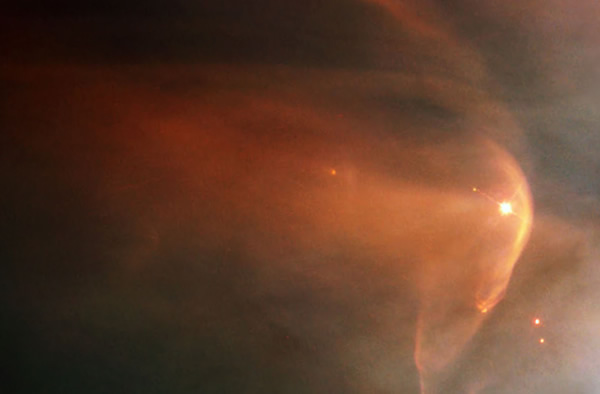Comet Tail Blazes from Solar System's Derriere
Hubble images a bright bow shock surounding a young star's astrosphere in the Orion Nebula. The shock is caused by stellar material interacting with the interstellar medium.
Scientists have long suspected that the solar system sports a tail, much like a comet flying through space.
But their first detailed look at it, painstakingly pieced together from three years of data collected by NASA’s Interstellar Boundary Explorer, or IBEX, spacecraft revealed a curiously shaped structure that somewhat resembles a four-leaf clover.
From its orbital perch around Earth, IBEX collects neutral atoms that form when electrically charged particles in the solar wind collide with cosmic rays at the edges of the heliosphere, the bubble of space under the sun’s influence.
The neutral particles, which aren’t impacted by the sun’s magnetic field, travel in straight lines from the collision sites. Some travel back toward the sun and end up inside IBEX. Scientists make use of the data to create maps of what is happening at the farthest reaches of the solar system.
“The scientists had always presumed that the heliosphere had a tail," Eric Christian, IBEX mission scientist at NASA’s Goddard Space Flight Center in Greenbelt, Md., told Discovery News. "We’ve seen it around other stars. We know that this sun is moving relative to interstellar gas and so we presumed that there was a tail. This is actually the first real data that we have that gives us the shape.”
Overall, the heliosphere is believed to be roughly bullet-shaped in the direction of travel and trailed by a tail that extends about 10 times farther back than the nose. The sphere is not symmetrical; it's misshapen by external interstellar magnetic fields. Those forces also sculpt the heliosphere’s tail.
“If you imagine putting bungee cords part way around a beach ball and pulling on them, they exert a force. And that’s the same sort of thing that a magnetic field line does,” said IBEX lead scientist David McComas, with the Southwest Research Institute in San Antonio, Texas.
“That force squeezes the heliotail so that it is actually flattened like an oval or an egg, and it starts to twist it and turn it in the direction in which the forces are the strongest, which is to align with the (interstellar) magnetic field,” McComas said.
IBEX’s findings may help another science team better understand the interstellar boundary region being explored by the long-lived Voyager probes. Last month, scientists reported that Voyager 1 is in a previously unknown corridor between the outermost part of the heliosphere and interstellar space. It is a region where particles from inside and outside the solar system can easily swap places, but the sun’s magnetic field still dominates.
Neither Voyager 1 or its sister probe Voyager 2 are in the direction of the solar system’s tail, but the picture coming to light of how interstellar magnetic fields impact the heliosphere may provide a better framework for understanding Voyager’s exit ramp.
The research appears in this week’s Astrophysical Journal.(Jul 10, 2013 06:30 PM ET // by Irene Klotz)












